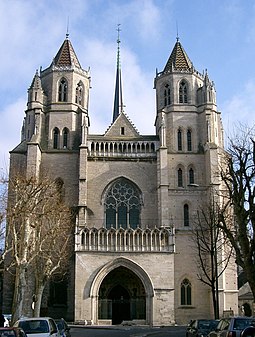Bishop of Dijon
|
Archdiocese of Dijon Archidioecesis Divionensis Archidiocèse de Dijon |
|
|---|---|

|
|
| Location | |
| Country | |
| Ecclesiastical province | Dijon |
| Statistics | |
| Area | 8,760 km2 (3,380 sq mi) |
| Population - Total - Catholics |
(as of 2013) 541,800 355,700 (65.7%) |
| Parishes | 60 'new parishes' |
| Information | |
| Denomination | Roman Catholic |
| Sui iuris church | Latin Church |
| Rite | Roman Rite |
| Established | 9 April 1731 (As Diocese of Dijon) 8 December 2002 (As Archdiocese of Dijon) |
| Cathedral | Cathedral of St. Benignus of Dijon |
| Patron saint | St. Benignus of Dijon |
| Secular priests | 133 (diocesan) 44 (Religious Orders) |
| Current leadership | |
| Pope | Francis |
| Metropolitan Archbishop | Roland Minnerath |
| Suffragans |
Archdiocese of Sens Diocese of Autun Diocese of Nevers Territorial Prelature of Mission de France |
| Map | |
 |
|
| Website | |
| Website of the Archdiocese | |
The Roman Catholic Archdiocese of Dijon (Latin: Archidioecesis Divionensis; French: Archidiocèse de Dijon) is a diocese of the Latin Rite of the Roman Catholic church in France. The archepiscopal see is Dijon Cathedral, located in the city of Dijon. The diocese comprises the entire department of Côte-d'Or, in the Region of Bourgogne. Originally established as the Diocese of Dijon in 1731, and suffragan to the Archdiocese of Lyon, the diocese was elevated to the rank of archdiocese in 2002. The most significant jurisdiction change occurred after the Concordat of 1801, when the diocese annexed the department of Haute-Marne. In 1821, a Papal Bull re-established the Diocese of Langres. The current archbishop is Roland Minnerath, appointed in 2004.
Between the years 506 and 540 it was revealed to Gregory, Bishop of Langres, an ancestor of Gregory of Tours, that a tomb which the piety of the peasants led them to visit contained the remains of St. Benignus. He had a large basilica erected over it, and soon travellers from Italy brought him the acts of this saint's martyrdom. These acts are part of a collection of documents according to which Burgundy was evangelized in the 2nd century by St. Benignus, an Asiatic priest and the disciple of St. Polycarp, assisted by two ecclesiastics, Andochius and Thyrsus. The good work is said to have prospered at Autun, where it received valuable support from the youthful Symphorianus; at Saulieu where Andochius and Thyrsus had established themselves; at Langres where the three brothers, Speusippus, Eleusippus, and Meleusippus, were baptized, and finally at Dijon. In the meantime the persecution of Marcus Aurelius broke out, and St. Benignus and his companions were put to death.
...
Wikipedia
